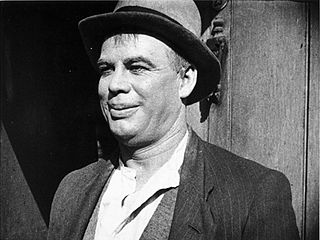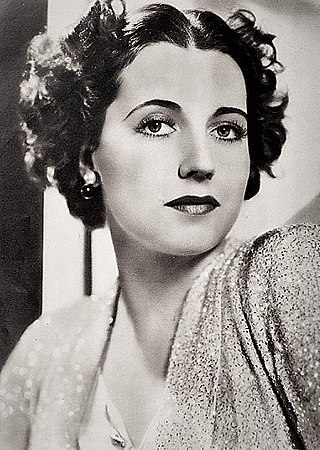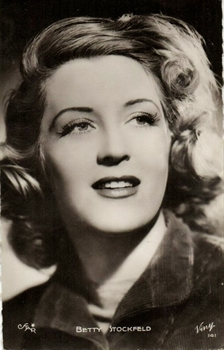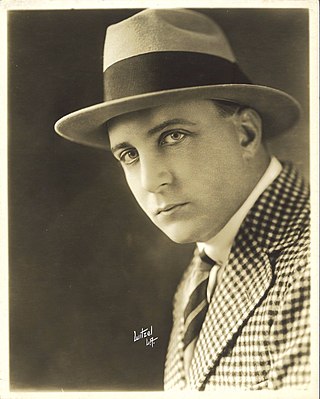Related Research Articles

John Villiers Farrow, KGCHS was an Australian film director, producer, and screenwriter. Spending a considerable amount of his career in the United States, in 1942 he was nominated for the Academy Award for Best Director for Wake Island, and in 1957 he won the Academy Award for Best Adapted Screenplay for Around the World in Eighty Days. He had seven children by his wife, actress Maureen O'Sullivan, including actress Mia Farrow.

The Sentimental Bloke is a 1918 Australian silent film based on the 1915 verse novel The Songs of a Sentimental Bloke by C. J. Dennis. Produced and directed by Raymond Longford, the film stars Arthur Tauchert, Gilbert Emery, and Lottie Lyell, who also co-wrote the film with Longford.

Cinesound Productions Pty Ltd was an Australian feature film production company. Established in June 1931, Cinesound developed out of a group of companies centred on Greater Union Theatres that covered all facets of the film process, from production to distribution and exhibition. Cinesound Productions established a film studio as a subsidiary of Greater Union Theatres Pty Ltd based on the Hollywood model. The first production was On Our Selection (1932), which was an enormous financial success.

Swallows and Amazons is a children's adventure novel by English author Arthur Ransome first published on 21 July 1930 by Jonathan Cape. Set in the summer of 1929 in the Lake District, the book introduces the main characters of John, Susan, Titty and Roger Walker (Swallows); as well as their mother, Mary; and their baby sister, Bridget. We also meet Nancy and Peggy Blackett (Amazons); their uncle Jim, commonly referred to as Captain Flint; and their widowed mother, Molly Blackett. It is the first book in the Swallows and Amazons series, followed by Swallowdale.

Mona Barrie was an English-born actress, active on stage in Australia before establishing a career in the US, and in Hollywood films.

June Clyde was an American actress, singer and dancer known for roles in such pre-Code films as A Strange Adventure (1932) and A Study in Scarlet (1933).

Norman O. Dawn was an early American film director. He made several improvements on the matte shot to apply it to motion picture, and was the first director to use rear projection in film production.

Herbert Sydney Wilcox CBE was a British film producer and director.
The Cheaters is a 1930 Australian silent film directed by Paulette McDonagh and starring Isabel McDonagh. Phyllis McDonagh worked as art director. The McDonagh sisters made a number of self-funded films together in the late 1920s and early 1930s.
For the Term of His Natural Life is a 1927 Australian film based on the 1874 novel by Marcus Clarke, directed, produced and co-written by Norman Dawn. It was the most expensive Australian silent film ever made and remains one of the most famous Australian films of the silent era.
His Royal Highness is a 1932 Australian musical film directed by F. W. Thring, also known as His Loyal Highness, starring George Wallace in his feature film debut. It was the first Australian film musical.

Betty Stockfeld, often misspelled "Stockfield", was an Australian film actress. She appeared mostly in British and French films.

Arthur Shirley was an Australian actor, writer, producer, and director of theatre and film. He experienced some success as a film actor in Hollywood between 1914 and 1920.
Fellers is a 1930 Australian comedy about three friends in the Australian Light Horse during the Palestine Campaign of World War I starring Arthur Tauchert, who was the lead in The Sentimental Bloke (1919). The film is mostly silent with a recorded music score as an accompaniment, but the last reel was synchronised with a few minutes of dialogue and a song.
Splendid Fellows is a 1934 Australian film from director Beaumont Smith about an Englishman who comes to Australia. The cast includes Eric Colman, brother of Ronald Colman, and Sir Charles Kingsford Smith, who has a cameo as himself. It was Smith's last film.

Arthur Michael Tauchert was an Australian acrobatic comedian, dancer, singer, film actor, and star of the Australian silent film, The Sentimental Bloke (1919).
The Adorable Outcast is a 1928 Australian silent film directed by Norman Dawn about an adventurer who romances an island girl. The script was based on Beatrice Grimshaw's novel Conn of the Coral Seas. It was one of the most expensive films made in Australia until that time, and was Dawn's follow up to For the Term of His Natural Life (1927). It did not perform as well at the box office and helped cause Australasian Films to abandon feature film production.

The Haunted Barn is a short 1931 Australian comedy film produced by F.W. Thring directed by Gregan McMahon. It was one of the first productions by Thring's Efftee Studios. The film was produced to support of the feature Diggers (1931) and shown on the same bill.

Peggy Pryde was a British music hall performer of the late 19th and early 20th centuries. She appeared in the early Australian talking film Fellers in 1930.
The Vicars Shield was a professional team golf competition between the states of Australia. It was first played in 1930 and continued as an interstate event until 1956. It was the professional equivalent of the amateur Australian Men's Interstate Teams Matches, which had been held since 1904. The trophy was donated by Sir William Vicars.
References
- 1 2 3 Andrew Pike and Ross Cooper, Australian Film 1900–1977: A Guide to Feature Film Production, Melbourne: Oxford University Press, 1998, p155
- ↑ "Showgirl's Luck". Filmnews . Vol. 17, no. 5. New South Wales, Australia. 1 June 1987. p. 7. Retrieved 5 March 2016– via National Library of Australia.
- ↑ Vagg, Stephen (23 December 2019). "Australian Film Musicals You Probably Didn't Realise Existed". Filmink.
- ↑ "GOOD Times". The Canberra Times . Vol. 61, no. 18, 934. Australian Capital Territory, Australia. 6 August 1987. p. 29. Retrieved 5 March 2016– via National Library of Australia.
- ↑ "AUSTRALIAN TALKIES". The Sydney Morning Herald . National Library of Australia. 11 October 1929. p. 13. Retrieved 7 August 2012.
- ↑ "AUSTRALIAN "TALKIES."". The Argus . Melbourne: National Library of Australia. 27 February 1930. p. 11. Retrieved 7 August 2012.
- 1 2 "BANKRUPT RADIO ANNOUNCER". The Sydney Morning Herald . National Library of Australia. 13 August 1940. p. 5. Retrieved 7 August 2012.
- ↑ "ABOUT THE SHOWS". Western Mail . Perth: National Library of Australia. 21 August 1930. p. 6. Retrieved 7 August 2012.
- ↑ "FILM WORLD". The West Australian . Perth: National Library of Australia. 4 March 1938. p. 4. Retrieved 28 March 2012.